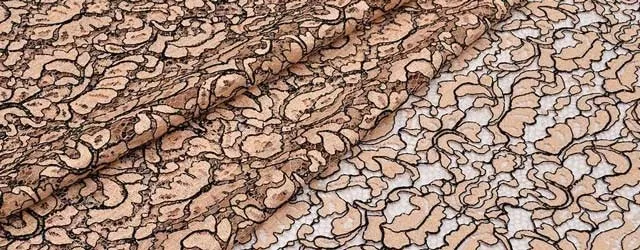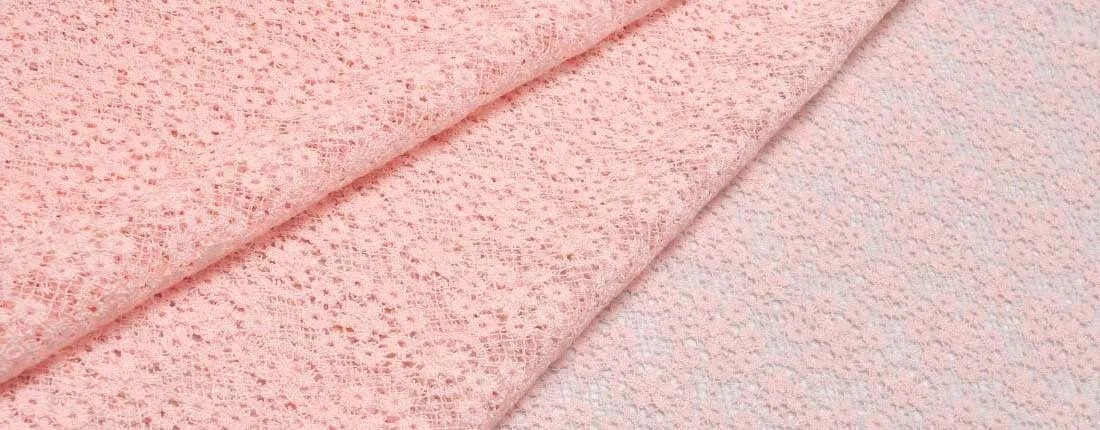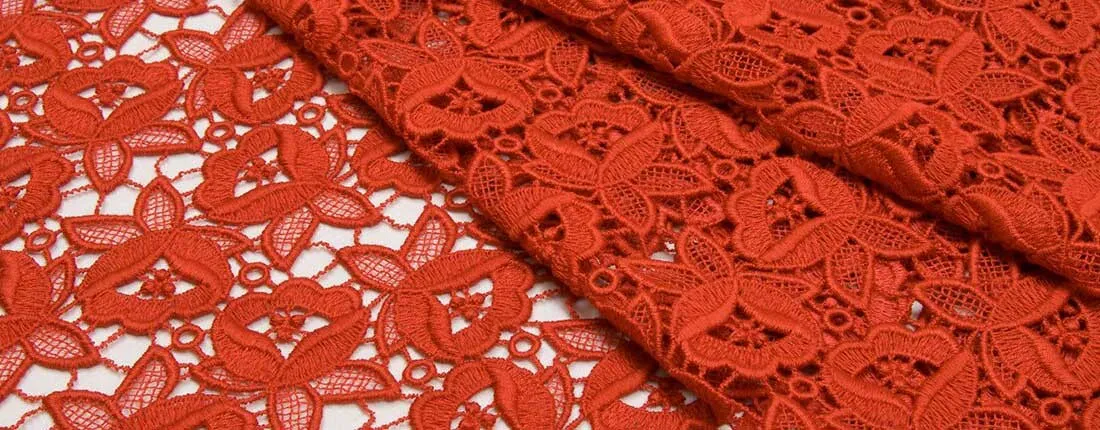
May 04, 2021
Lace Guide: Pros and Cons, Properties and Qualities, How to Care
Laces are works of textile art; they bring a complete graceful touch to any dress outlook.
Pros and Cons
Every fabric has pros and cons and lace is not an exception as well.
Advantages

● Appealing – The embroidery laces look chic, fabulous and feminine. It is best to give a romantic look.
● Beautiful – Lace is available in the vibrant and rich colors.
● Breathable – The lace fabric is breathable and has a pleasant texture.
● Festive – Casual clothes decorated with lace look stunning than any other fabric; a perfect source to adorn any festive dress.
● Long-lasting – The thread in lace fabric is highly durable enough to deal with the use of daily wear, although you should ideally be careful.
● Versatile – Lace fabric is an ideal choice for either evening parties, good finishing, for casual clothes, and to name a few.
Disadvantages
● Fragile – Lace fabrics are easy to get damaged.
● Labor-consuming Care – There is no doubt that you cannot wash lace dress in the washing machine. Dry-cleaning will be the best option, but a hand wash is also possible. Remember to dry any garment with lace horizontally.
● Pricey – In general, laces made of natural materials by leading European textile manufacturers are expensive. Handmade lace fabrics are more expensive than machine-made.
● Transparency – Lace can be used as separate elements or in combination with other materials. One may also insert a lining for more opacity and embed a covering for greater murkiness.
Properties and Qualities

● Either hand-made or machine-made, almost all types of lace are an openwork fabric.
● Depending on how they are made, its weight can be lightweight or heavy.
● Laces are breathable, sheer and delicate to touch especially if made with silk, cotton or wool.
● Synthetic lace fabrics are more durable than handmade ones.
● Laces come in different patterns and designs; be it floral or ornamental or geometric with stripes, checques, and waves.
● Metallic threads add shimmering to the fabric.
● The lace fabric is ideal for evening/night, wedding and easygoing wear, home materials, lingerie, and finishing. How to Care for Lace Fabric?
How to Care for
Lace Fabric?

Dry-cleaning is the most preferred option since lace fabric requires a delicate care. The best way is to check the care label before washing.
● If hand wash is allowed, use a gentle cleaning agent, cold water, and dry on a towel after washing.
● If your lace fabric is machine washable, choose the delicate mode, use a wash bag and mild detergent.
If the water temperature is higher than recommended, shrinkage of fabric is possible. Beware that embroidered lace is not washable in any situation.
Do not iron the lace. Most of the lace dresses require no ironing. If the lace contains synthetic fibers, ironing can make them melted.
If you want to iron your lace dress, treat it very carefully. Put the lace on a towel and place a plain cloth or a press cloth fabric between the iron and lace. Choose the proper temperature or gradually raise the temperature from cool to cool-medium.
To avoid stretching, dry heavy lace apparel flat.

Sources
https://tissura.com/articles/lace-fabrics
https://blogging2k19.blogspot.com/2020/04/pros-cons-good-features-of-lace-fabric.html
http://eyeletlacesuppliers.over-blog.com/2017/12/pros-and-cons-of-embroidery-lace.html
B03-unitedlace_com-YV
Dealers of lace fabric at wholesale prices. For more information, inquiries, or questions:
📞Call :
083-447-8965
📌Line Official :
United Lace
📸IG :
@unitedlace
🌐Website:
https://www.unitedlace.com/
#unitedlace #lace #embroidery #cottonlace #drylace #fancylace #frenchlace #eyelet #chantillylace
Other Blog Page
-
How to Choose the Right Lace for your skin?
Lace Fabric Trend : Embrace Summer with Style
Beat the Heat in Style : Top 5 Fabrics for a Hot Summer Wardrobe
Wearing Lace Outfits : How to Look Stunning and Catch Every Eye
"Lucky Red" Fashion Tips for Chinese New Year Festival
The 4 Most Popular Types of Lace Fabrics Today
Here it is! 7 Trending Colors of the Year 2024
Sizzling Party Looks to Welcome the New Year!”
"Beautiful, Eye-Catching” with every gaze! Welcome Christmas with 'Red Lace Fabric'
Choosing Appropriate Lace Fabric for Different Occasions
Chantilly Lace Fabric: Inspired by Vintage Style
The Charm of Lace Fabric: Captivating Beauty that Mesmerizes
-
Create a Casual & Chic Look with Lace Fabric: Effortless Elegance
-
Party Look - How to Look Stunning and Stand Out at the Party
-
Contemporary Lace Fabric in Boutique Style
-
Thai Fabric: Exquisite Beauty with Distinctive Identity
-
Fashion Tip: Choose fabrics to suit your tailoring
-
Lace Fabric : Symbol of Ultimate Femininity
-
14 Types of Lace Fabric and Trims for Dressmaking
-
Lace Guide: Pros and Cons, Properties and Qualities, How to Care
-
Different Lace Fabrics Come with Different Feature, Choose Wisely for Your Dream Wedding Dress!
-
How to Tell If the Lace is Good Quality?
-
Modern and beautiful lace dress in Thai style
-
What is Chemical Lace ... ?
-
Is it difficult to maintain a lace dress?
-
Tips for selecting clothing that flatters your figure
-
Mix & Match: Clothing for different Skin Color
-
Elegant & Luxurious French Lace
บทความอื่นๆที่น่าสนใจ
-
เลือก "ผ้าลูกไม้" อย่างไรให้เข้ากับสีผิวของคุณ
กล่องเบญจรงค์ลายลูกไม้หนึ่งในนวัตกรรมจาก "ผ้าลูกไม้"
เทรนด์แฟชั่น ผ้าลูกไม้ฉลุ สวยฉํ่ารับซัมเมอร์
‘ผ้า’ แบบไหนเหมาะที่จะใส่ในช่วง 'หน้าร้อน'
ใส่ชุดลูกไม้อย่างไรให้คุณดู สวยและสะกดทุกสายตา
Lucky Red เทคนิคการแต่งตัวรับโชคในเทศกาลตรุษจีน
มาแล้ว! 7 เฉดสีเทรนด์สีมาแรงแห่งปี 2024
ผ้าลูกไม้ 4 ชนิดที่ได้รับความนิยมมากที่สุดในปัจจุบัน
ลุคปาร์ตี้สุดแซ่บ ต้อนรับเทศกาลปีใหม่
สวยสะดุดทุกสายตา! “ผ้าลูกไม้สีแดง” ต้อนรับคริสต์มาส
การเลือกผ้าลูกไม้ ให้เหมาะกับการใช้งาน
ผ้าลูกไม้ Chantilly Lace แรงบันดาลใจจากสไตล์วินเทจ
ดูแลชุดผ้าลูกไม้อย่างไร ให้อยู่กับคุณได้นาน
แฟชั่นของผ้าลูกไม้ ความงดงามที่ไม่มีวันจางหาย
ผ้าลูกไม้โทนสีดำ เพิ่มเสน่ห์ หรูหราอย่างมีระดับ
ผ้าลูกไม้ Embellished Embroidery : แรงบันดาลใจจากสไตล์วินเทจ
ผ้าลูกไม้ เนรมิตเจ้าสาวให้งดงาม หรูหรา สุดเลอค่าในวันสำคัญ
รู้หรือไม่ "ชุดลูกไม้" ไม่ว่าจะช่วงเวลาไหนก็เป็นที่นิยม
เสน่ห์ของผ้าลูกไม้ ความงดงามที่ชวนน่าหลงใหล
-
จัดลุค Casual เรียบง่ายแต่ดูแพง ในสไตล์ ผ้าลูกไม้
-
Party Look แต่งแบบไหนให้สวยแซ่บแย่งซีน
-
ผ้าลูกไม้นําสมัยในสไตล์ Boutique
-
"ผ้าไทย" ความงดงามที่มีเอกลักษณ์
-
ผ้าลูกไม้สําหรับผ้าลูกไม้ " Guipure Lace " ความคลาสิกที่ไม่เคยเป็นอดีตตัดชุดเจ้าสาว
-
ผ้าลูกไม้สําหรับตัดชุดเจ้าสาว
-
ใครว่าผู้ชาย "ใส่ผ้าลูกไม้" ไม่ได้
-
เทคนิคการเลือกเนื้อผ้า สำหรับการตัดเย็บเสื้อผ้าเพื่อความเหมาะสม
-
จะทราบได้อย่างไรว่าลูกไม้มีคุณภาพดี?
-
เคล็ดลับวิธีการเลือกชุดแต่งงานในฝันของคุณ!
-
ข้อพิจารณาต่างๆสำหรับการเลือกลูกไม้
-
ผ้าลูกไม้ 14 ชนิดที่ได้รับความนิยมในอุตสาหกรรมแฟชั่น
-
ผ้าลูกไม้ (Lace fabric) คือหนึ่งในสัญลักษณ์ของความเป็นผู้หญิง
Quick Link
Information

215 Soi Yawaraj 23, Jakkawat, Samphanthawong, Bangkok 10100, THAILAND

Tel : +66834478965

Email : [email protected]
Contact Us







